Hate speech, atrocities and fake news: the crisis in Myanmar
Roula Khalaf, Editor of the FT, selects her favourite stories in this weekly newsletter.
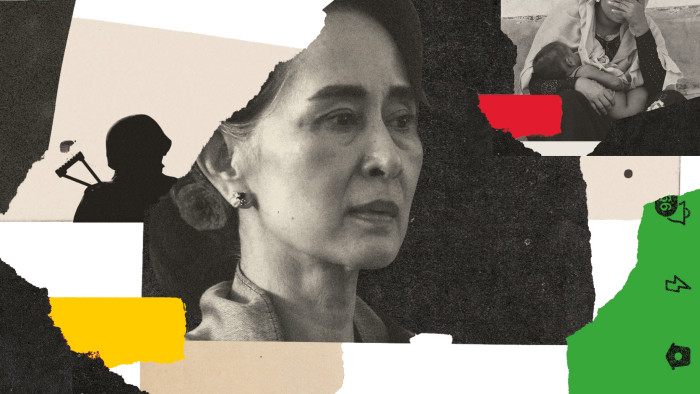
Last year, as Rohingya Muslim men, women and children ran from their burning villages in Myanmar’s western Rakhine state, an alarmed world turned to the internet for news. Some looked at The Irrawaddy, a publication named after the country’s signature river, which has been a pillar of journalistic probity since the student activist Aung Zaw founded it in 1993.
The website, which publishes in English and Burmese, has covered all of Myanmar’s big moments, from the “Saffron Revolution” in 2007 to Cyclone Nargis in 2008 to the triumph of Aung San Suu Kyi’s National League for Democracy in 2015.
As the military “clearance operations” targeting Rohingya unfolded, impartial information was at a premium. Authorities had closed northern Rakhine state, the centre of the violence, to journalists, who resorted to tracking fires from across the river in Bangladesh. The arriving Rohingya told stories of shootings, machete attacks and rapes by security forces and civilians that were to precipitate one of the fastest mass movements of people in modern times.
But while the western press covered the violence widely, regular readers of The Irrawaddy’s English-language website noted some puzzling changes. The publication, which had previously been criticised by nationalists for its robust reporting on the persecuted minority, had started to label them as “self-identifying Rohingya”.
Rohingya is a loaded word in Myanmar and rejected by nationalist Bamars, the ethnic group who dominate government and public life and see the minority as illegal “Bengali” immigrants.
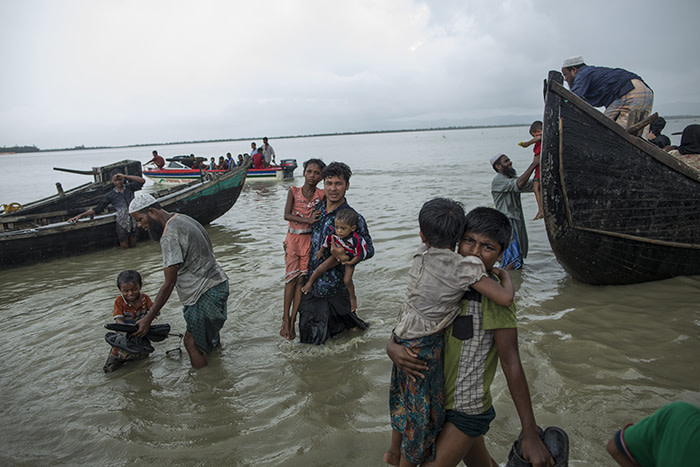
As the refugees continued to pour into Bangladesh — their number would reach nearly 700,000 by early 2018 — international outrage spread, and with it calls to censure Aung San Suu Kyi, Myanmar’s civilian leader. But The Irrawaddy defended her. “Many groups and institutions in the West are humiliating Daw Aung San Suu Kyi as well as the country,” the site wrote in one of its many defiant editorials.
Rather than training its attention on what US and UN officials called ethnic cleansing, the publication focused on what it claimed was biased foreign news coverage of the exodus, and printed cartoons that tapped into a surge in nationalism and anti-Muslim sentiment.
Human-rights advocates expressed disappointment and alarm. “The Irrawaddy have switched over and aligned themselves with the prevailing narrative; they used to be independent and strongly in favour of democracy,” Khin Zaw Win, one of the few political commentators in Myanmar to have bluntly criticised Aung San Suu Kyi’s government on the Rohingya and other issues, told me. “There is a struggle, a debate going on in the media, and the majority of the public feel this way.”
This is not a story solely about the media, except to the extent that many stories these days are about media credibility, the manipulation of social media and the perils of false news reports, whether in Brexit Britain or Trump’s America. Nor is it solely about The Irrawaddy, except to the extent that it stands for an ideal of journalism and the deep sacrifices the Burmese population — including some of its own journalists — paid for their freedom.
Instead it is about a moment when many of the democratic forces that successfully challenged military rule in Myanmar are closing ranks around a nationalist and apologist script that increasingly puts them at odds with the western world. A uniquely unsettling moment in the country’s history is playing out in the press and social media, where new internet freedoms have enabled both incisive journalism and the spread of hate speech and false reports. Some journalists have been arrested or received death threats. Others are preparing to leave. Myanmar’s estrangement from the west is deepening, as is its determination to tell its own story on its own terms — even when the facts don’t line up.
Since last autumn, the simple narrative of freedom triumphing over tyranny has no longer pertained in Myanmar — if it ever did — complicating the writing of diplomatic cables and journalistic reports alike. Aung San Suu Kyi, a unifying force while under house arrest for almost 15 years, is foundering in power. The 2008 constitution that paved her way to office left the generals in control of three government ministries and a quarter of parliamentary seats, enough to block further reform. Even sympathetic observers describe her micro-managing style as undermining the government’s ability to make decisions.
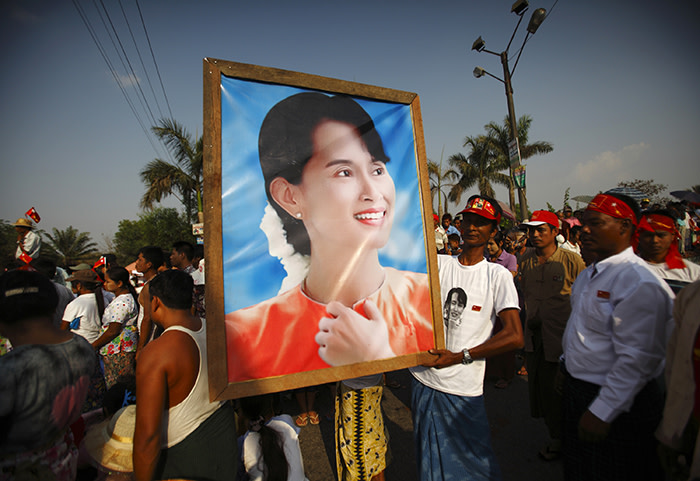
The military’s rampage against the Rohingya last year was without Aung San Suu Kyi’s apparent consent or prior knowledge. However, her response to international outrage has been defensive and — to most observers outside Myanmar — inadequate. “She is proving to be the wrong person at the wrong time for Myanmar,” says Phil Robertson of Human Rights Watch. “We were hoping that she would provide the charismatic leadership needed to bridge divides — to say to ethnic minorities, ‘We can work with you’; to solve the Rakhine situation; to move the military out of politics and back to the barracks — and in all these things she’s failing.”
As Myanmar’s transition towards democracy was beginning in 2012, the opening up of the internet — where the majority of citizens now get their news — allowed old grievances to reignite and spread fast. The rape and murder of a Buddhist woman by Rohingya men that year caused rioting that killed about 200 people. Zaw Htay — then spokesman for President Thein Sein and now for the Aung San Suu Kyi administration — was accused of fanning the flames by posting incendiary pictures on Facebook, which most people in the country now access as a primary news source on their mobile phones.
According to the Yangon-based tech innovation lab Phandeeyar, Myanmar now has more active Sim cards than people, and 90 per cent of the population live within range of mobile broadband.
Communal violence flared again in Rakhine last August, when militants who call themselves the Arakan Rohingya Salvation Army, or ARSA, attacked police posts and an army base, killing 12 and prompting the Burmese military’s ferocious crackdown. In December, Médecins Sans Frontières estimated that at least 6,700 Rohingya had died from violence in the month following the ARSA attacks.
While journalists are still barred from northern Rakhine, the Associated Press recently pieced together evidence of at least five mass graves there; Aung San Suu Kyi’s office dispatched a ground team to the scene and declared the report was “not true”. A spokeswoman for the AP said the agency stood behind its reporting.
“Can we work here, or are we supporting apartheid?” one foreign diplomat in Yangon, Myanmar’s largest city, asked me in an unusually frank moment recently. The UK, US and EU have taken some steps to censure and isolate the military but are loath to cut off Myanmar’s government or reimpose economic sanctions, for fear of hurting ordinary people or derailing what they see as a delicate democratic experiment.
But the ground is shifting in Myanmar, as pressure, harassment and even the full weight of the law are brought to bear on journalists. One evening last December, two young reporters for Reuters’ Yangon bureau, Wa Lone and Kyaw Soe Oo, were invited to a restaurant by police officers who handed them documents. They were arrested outside. The following day the information ministry said that they had been charged under the Official Secrets Act for having “illegally acquired information with the intention to share it with foreign media”. They are currently in Insein prison, where thousands of dissidents, including journalists and current government officials, served time in the days of military rule.
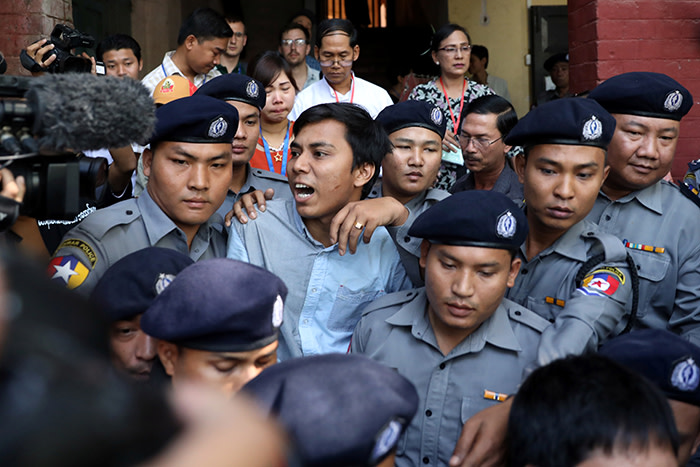
In February, Reuters published the exposé on which the pair had been working: a meticulously sourced report about the slaughter of 10 Rohingya men, who were picked at random by soldiers from a group of displaced people in the village of Inn Din. As the case drags on, the reporters’ imprisonment has become a defining moment for how the new Myanmar is perceived in the outside world.
In a less widely reported incident, Esther Htusan, the Associated Press correspondent in Yangon, recently left the country after receiving death threats. The online harassment began when — hours before news of the August attacks emerged — she appeared on a panel and spoke of suspected human rights abuses by the military in Rakhine. In November, one of her reports seemed to suggest that Aung San Suu Kyi was saying illegal immigration caused terrorism.
The AP corrected it but the Myanmar Broadcasters Association denounced Htusan. She fled to Bangkok after a prominent nationalist, with more than 300,000 Facebook followers, called her a “bitch” and said she should be killed if she “touches our leader”. Htusan declined to comment for this article.
Other Burmese journalists are also feeling the brunt of a more hostile working environment. Kyaw Lin, a contributor to the news group DVB, was stabbed in the back recently by two unknown assailants on a motorbike when reporting in Sittwe, the Rakhine state capital.
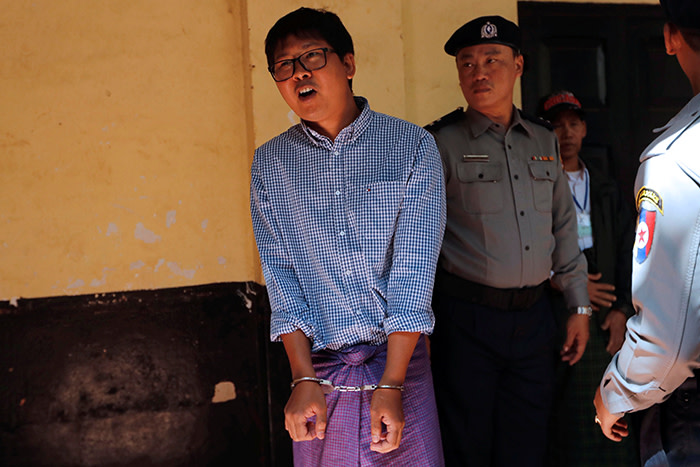
Prosecutions of journalists under a draconian criminal libel offence pursuant to Article 66(d) of the country’s Telecommunications Law have surged. Swe Win, chief editor of the site Myanmar Now, was arrested last year and charged over a Facebook post critical of U Wirathu, a Buddhist monk known for his anti-Muslim rhetoric. In January, the Committee to Protect Journalists “awarded” Aung San Suu Kyi the dubious distinction of being the world’s biggest backslider on press freedom in 2017.
I moved to south-east Asia for the Financial Times in September, in the first days of the military campaign against the Rohingya. I have reported from Myanmar three times since, most recently in January. Journalist visas are becoming harder to obtain. For my most recent visit, I had to give a detailed itinerary and sign a declaration that I would not visit “restricted and operational areas”.
Journalists rarely want to become part of the story, but in Myanmar there is now a serious risk of this happening. Some of the expat correspondents based in Yangon are preparing to pack up and leave for good. When I asked to interview a prominent Buddhist nationalist group for this story, they agreed on the condition that I allow them to videotape the recording and publish it. (My local fixer advised I decline, and I did.) Late last year, when I was interviewing two human rights activists in a restaurant, I noticed a woman recording us on her phone. As we finished, she followed me out, still filming.
The sympathy the Rohingya have received in the outside world has inflamed anti-Muslim sentiments inside Myanmar, where most of the public agree with the official line that the country is under attack from terrorists and separatists. “Views inside and outside the country of what happened in Rakhine are not just different, they are diametrically opposed,” Thant Myint-U, the historian, told me. “Perceptions of the crisis have been veering in opposite directions for some time, but it’s the violence of the past year, and the vastly different narratives around what actually happened, that’s created an almost unbridgeable divide.”
Muslims — who make up 4 per cent of the population — have been part of the country’s social fabric since long before independence in 1948. But from the 1970s, they began to face growing restrictions on many of their basic rights, including in some cases citizenship and a 2015 law that allows private third parties to block mixed-faith marriages. Radical monks have spread hatred of Islam. In March 2015, the US Holocaust Museum commissioned a report on what it called “early warnings of genocide in Burma”. It focused primarily on the Rohingya, and mentioned the denial of citizenship, movement restrictions and “rampant hate speech” they faced.
The Rohingya are now largely a people in exile — well over half of their pre-violence population are abroad. However, human-rights advocates say there is a lingering risk both to those who remain and to the roughly one million non-Rohingya Muslims who still live in Myanmar’s Buddhist heartland. “The growth of hatred is very strong,” says Kyaw Win, a Muslim exile based in the UK, whose Burma Human Rights Network has documented the plight of Muslims in Myanmar. “Anything could trigger bloodshed. I have been saying since 2012 that Burma could become a second Bosnia or Rwanda, and it’s happening right now.”
Many think that a bombing attack or other incident for which Muslims claim responsibility could spark new violence. Both ARSA and al-Qaeda have threatened to strike inside the country, but it is by no means clear how serious these threats are. Some have gone so far as to speculate that the military, who have seen their popular support surge since August and who have been implicated in past outbreaks of communal violence, could stage a “false flag” attack to stir things up. “You get one bomb going off in Shwedagon pagoda and it’s going to be a bloodbath all over Myanmar,” one long-time expat in Yangon told me.
Experts in conflict resolution and mass-atrocity prevention say they continue to see “dangerous speech” in Myanmar. “There are a couple of patterns that arrive over and over,” said Rachel Brown, founder of Over Zero, an NGO fighting hate speech. These include dehumanisation, “removing people from the contract” or saying a given minority is a threat to women and children. “This rhetoric builds up and escalates; the construction of a threat is most important in this process,” she added. “Myanmar is one of the most concerning contexts in the world for this stuff right now.”
The Irrawaddy’s editors are all too aware of the controversy around their recent coverage, which has come up in private conversations with donors and their own staff. Kyaw Zwa Moe, the English-language editor, is the younger brother of founder and editor-in-chief Aung Zaw. We met one afternoon in Yangon. (Aung Zaw and I traded emails, but he did not want to be interviewed.) Kyaw Zwa Moe, 46, is slim, wears glasses, and has a youthful look that belies the fact that he spent eight years as a political prisoner. “We have two audiences: people in Myanmar and people in the international community,” he said. “We cover the news for both of them; we do what we are supposed to do.”
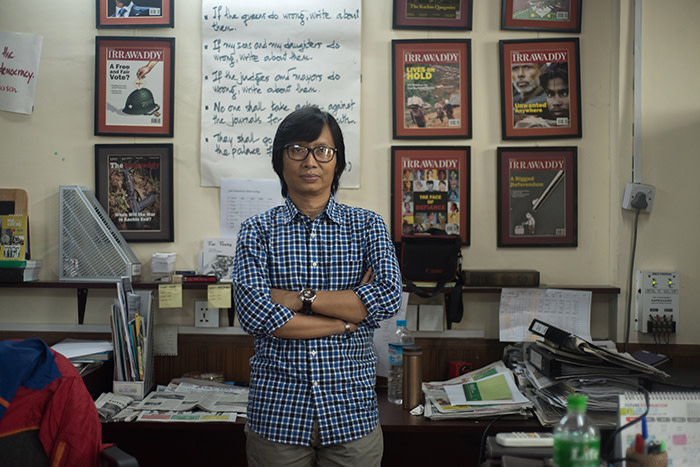
The problem, he said, “is that the international community sees our coverage differently: we are trying to portray the real situation of Myanmar, and also the very complex situation of Rakhine in this issue”. This remark echoed similar ones made by Aung San Suu Kyi and other officials, who accuse foreigners of dwelling on the Rohingya crisis at the expense of the many other problems plaguing Myanmar — economic deprivation, the balance of power between the government and the military, and armed conflicts with other ethnic groups.
Kyaw Zwa Moe was a teenager in 1988, when anger against the regime swept into mass street protests. While Aung Zaw took part in demonstrations, Kyaw Zwa Moe was an activist at his high school. As the protests gathered strength, the regime responded with force. Aung Zaw was arrested and spent a brief time in prison before fleeing to Thailand.
Kyaw Zwa Moe stayed on in Myanmar, publishing a clandestine political journal with his friends, but fell into the authorities’ net after Aung San Suu Kyi received the Nobel Peace Prize in 1991 and the military rounded up activists. He was tortured, with beatings and sleep deprivation, during what he calls “10 days in hell” at two interrogation centres, before being sentenced to 10 years in prison.
Over in Thailand, his brother was starting up The Irrawaddy, then a print publication, with the aim of reporting on a country under censorship and military rule. Aung Zaw built up a team of reporters who worked the phones and debriefed travellers at the Thai border. “The world was thirsty for information, and that’s why Aung Zaw founded it — and why we published in English first,” Kyaw Zwa Moe told me. The Irrawaddy launched its English-language website in 2000 and its Burmese one in 2001.
After the collapse of communism in Europe and apartheid in South Africa, charitable foundations became convinced of the value of independent journalism and support surged. The Irrawaddy got funding from donors including the National Endowment for Democracy and George Soros’s Open Society Foundations. Kyaw Zwa Moe was freed in 1999 and fled to Thailand to join his brother.
In 2012, after the regime began negotiating a path towards democracy, Myanmar lifted censorship and the firewall blocking its internet, and The Irrawaddy opened an office in Yangon. It joined other privately funded publications like DVB, as well as the pre-existing state-run Global New Light of Myanmar newspaper. Although still dependent on donors, The Irrawaddy built up its audience, gaining legions of local readers for both its Burmese- and English-language websites.
It hired young expat journalists, who began arriving as the country’s first democratic election approached. Meanwhile, the opening up of the internet was increasing the influence of Buddhist extremists, which spread via websites, online sermons, publications and videos.
When violence erupted in Rakhine in 2012, The Irrawaddy came under attack for using the word “Rohingya” in its coverage. In a 2013 op-ed piece in The New York Times, Aung Zaw condemned the rise in hate speech and nationalism, and chided Aung San Suu Kyi, then in opposition. “To be as respected as Mohandas K Gandhi and Nelson Mandela, she must explicitly condemn the bloodshed against Rohingyas, Kachin and other minorities, and criticise the police and security forces for their negligence and complacency,” he wrote.
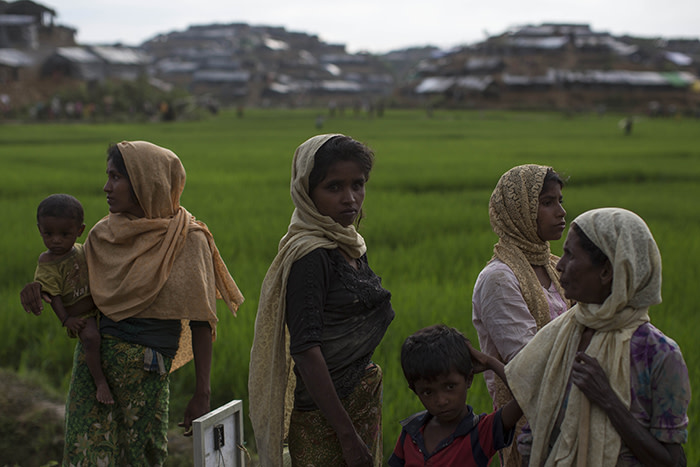
In 2014, Barack Obama granted The Irrawaddy an interview on his visit to Myanmar, and the Committee to Protect Journalists gave Aung Zaw a press freedom award, citing the pressure his publication faced from the authorities. That same year, the website was hacked by unnamed attackers on the grounds that it “supports jihad and radical Muslims”.
But around the time of the electoral campaign in 2015, some English-language editors began to notice a change. The Irrawaddy threw its full weight behind what was to be a successful bid for power by the National League for Democracy. According to several of its former foreign journalists, the publication on occasion suppressed stories that would have cast the NLD in a bad light.
Kyaw Zwa Moe denied this, saying the site will “not shy away” from criticism of Myanmar’s new democratic institutions. “We have published many critical stories on the NLD, including its failure to have Muslim candidates in the 2015 election,” he said in an email. “Our mission is to help rebuild our country as a democratic society out of the debris of bad legacies, both under British colonialism and authoritarian rule, by practising hardcore journalism with loyalty to citizens.”
In 2016, The Irrawaddy ran one of its most controversial cartoons. Captioned “Me First”, it showed a dark-skinned, shirtless man wearing a sign reading “boat people” — obviously a Rohingya — barging his way to the front of a queue of people dressed in the garb of Myanmar’s other national groups. Then, after last August’s attacks, senior editors of the English site told staff they were to use the term “self-identifying Rohingya” and then “Muslim in Rakhine” on the second reference.
As the violence in the country spread, arguments broke out at the paper. Some of the foreign staff complained about the lack of Rohingya sources and the commissioning of stories that focused on Buddhists and Hindus uprooted in the violence, rather than the Rohingya. “It was a sad realisation to see people who fought so long for freedom were on the wrong side of something that would now define the history of the country going forward,” one of the expat former editors, speaking anonymously, told me. (Three out of four of the publication’s English copy editors quit over a short period last autumn.)
I interviewed Ye Ni, the editor of the Burmese edition, who signed off on the controversial “Me First” cartoon. “I understand the message that the cartoonist wants to say: Myanmar is a very fragile country with many other issues — civil war, economic development — not only the Rohingya issue.” He said that editors were doing their part to eliminate hate speech in reader comments. “Since 2012, they accused The Irrawaddy of being pro-Muslim . . . pro-Rohingya, national traitors because of our coverage of the conflict. We never changed.”
The publication isn’t alone in taking a more patriotic tone; other Burmese news sites with which it competes, including Mizzima and DVB, run coverage that often reflects a nationalist mindset. “The Irrawaddy’s reluctance to challenge the government narrative on the Rohingya crisis is very disappointing, but it represents a much broader failure of the pro-democracy movement — both inside and outside the NLD — to honour human rights principles in the face of dehumanising narratives of ‘illegal immigration’ and terrorism,” Ben Dunant, a former English-language editor, told me. The paper, he took pains to add, remains “a relatively moderate voice on the crisis” in Rakhine, and has done “great work” in reporting on military abuses in other parts of Myanmar.
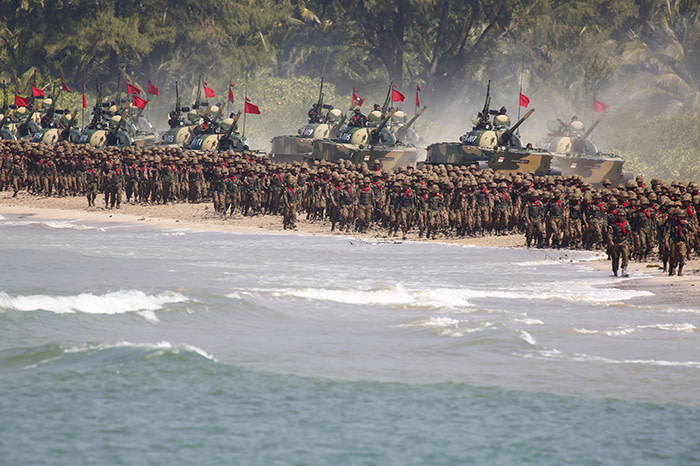
In recent months, the National Endowment for Democracy, one of The Irrawaddy’s biggest foreign donors, has faced questions from human rights groups and journalists over whether it will continue its grants of more than $100,000 a year, while Soros’s Open Society Foundations have privately raised concerns over the cartoons with The Irrawaddy’s staff.
Others speculate that Myanmar’s independent media may be moving away from the donor-funded model to a more commercial one, necessitating a change in tone to curry favour with Burmese businessmen known as “the cronies”. “They probably feel that in order to survive, they need to make their peace with local business interests, and that may explain some of the stuff they are publishing right now,” said Jason Nelson, a Canadian journalist who formerly worked for The Irrawaddy in Thailand.
Kyaw Zwa Moe rejects this, asserting that The Irrawaddy has been “critical of those in power without favour or fear” and noting that nationalists have targeted both the publication and individual reporters. “No matter who our donors/sponsors/advertisers are, we have never compromised our editorial policy and independent journalism,” he told me. “Neither will we do so in future.”
The growing blowback against legitimate newsgathering in Myanmar has affected The Irrawaddy as well as other publications. One of its reporters was arrested last June in the Shan state and held for two months. Another was accosted in December by a group of villagers in northern Rakhine and interrogated by police officers for several hours. The Irrawaddy has joined foreign media in criticising the detention of the two Reuters reporters. “All journalists here are under threat in a way when it comes to covering all sensitive issues,” Kyaw Zwa Moe said.
Unlike many other Asian countries, Myanmar does not censor the internet. Citizens searching for news increasingly turn to the unregulated online shallows, where calls for violence spread with apparent impunity. Facebook takes down content flagged as abusive or racist, but users here commonly cut and paste these posts before they are removed, meaning incitement continues to be disseminated.
“Most of the hate speech here is based on what nationalists say happened under British colonialism: Muslims from India came here to help the British administration and married Burmese women, occupying the land,” Ye Myint Win, a pro-Rohingya Muslim activist who goes by the name Nickey Diamond, told me. “These stories are revived and poorly interpreted.”
Incitement to violence against minorities was common during the days of the military dictatorship, when pamphleteers wrote printed screeds that were circulated by hand. But the arrival of the internet allows threats, rumours and libels to spread on an unprecedented scale. “The fact that Facebook is the internet for many digital users, combined with low levels of digital literacy, makes fake news and online hate speech particularly dangerous in Myanmar,” said Victoire Rio of Phandeeyar, the Yangon-based tech group that she says is working to promote “safe” internet usage.
One widely read propaganda page on Facebook is Lwin Pyin (The Field). It has more than three million followers and publishes fake news reports alongside lifestyle features. Recently, it published a counterfeit post claiming that Yangon’s chief minister wanted to destroy two stupas (shrines) at Shwedagon Pagoda, news that would anger any Burmese Buddhist. The story went viral. It was false.
Some of the misinformation appears calculated to create chaos. Last year, a few days before the anniversary of the September 11 attacks and less than two weeks after ARSA’s attacks in Rakhine, twin chain messages were widely distributed via Facebook Messenger. One claimed that Muslims were preparing to launch “jihad” in the country on the 9/11 anniversary; another, sent to Muslims, said that the Buddhist extremist group was preparing to attack kalars — a racial slur for dark-skinned people of south Asian descent. In response, mobs attacked Muslim houses, shopfronts and a mosque in the towns of Magway and Taungdwingyi, before being dispersed by riot police.
Nickey Diamond has been subjected to online harassment and numerous threats to his life. After he appeared in a debate alongside the AP’s Htusan, in which he criticised the military for limiting media access to Rakhine, his landlord evicted him from his flat and he now lives behind a metal security gate. He has an infant daughter with his wife, who is a practising Christian registered as a Buddhist, but the couple have not legally married because they fear nationalists would torpedo the union under the 2015 law. He says two men, who he believes are state and military security functionaries, tail him wherever he goes, but he is determined to continue his work. “If we stop fighting, we will lose everything. We can’t stop what we are doing,” he says. “If we do, they won’t stop what they’re doing.”
One morning I travelled to Sin Ma Kaw, one of a number of Myanmar villages that have proclaimed themselves “Muslim-free”. Deep in a rural area, it is a place with few opportunities outside farming. The townspeople received me politely, if a bit warily. They told me Muslims, Christians and Hindus were not allowed to settle, sleep or build their houses of worship there. “Everybody can visit but they cannot stay here,” said U Aye Swe, the village leader, as we drank tea beneath a Buddhist altar. “Muslim people cannot build their mosques; Christian people cannot build their churches.”
According to the Burma Human Rights Network, there are about two dozen such villages across the country. “Muslim people do terrorism; we are very afraid of terrorism,” U Aye Swe said. “And if one of our people marries a Muslim, the attitudes of the Muslims transfer to Buddhist people. We don’t like it, and we don’t want it. The main reason is the faith.”
In January, I interviewed Pe Myint, the information minister in Naypyidaw, Myanmar’s sprawling new capital. The only address I was given — enough for the taxi driver — was Building Number Seven, a low-rise modernist block with Soviet-reminiscent murals of Burmese pagodas, monuments and buildings.
Pe Myint is an ethnic Rakhine, a member of the mostly Buddhist ethnicity who give the state its name. Under the old regime he was a physician before becoming a writer, editor and translator of books ranging from Chekhov to Chicken Soup for the Soul. In an interview with The Irrawaddy in March 2016, he promised to ensure press freedom.
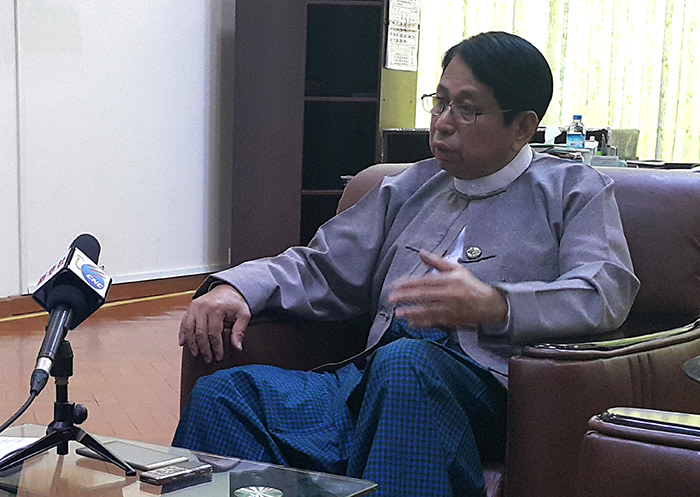
In his office, I was surprised to see cameras recording our interview. While we talked, the Reuters reporters Wa Lone and Kyaw Soe Oo were in court in Yangon. Pe Myint served as Wa Lone’s editor when the latter was a reporter at The People’s Age Journal. I asked him whether it was proper for a democratically ruled country to be jailing journalists. “I do not know the exact nature of what happened,” he said.
He spoke of the imperfect nature of Myanmar’s democratic transition, a point often made by members of Aung San Suu Kyi’s government. “I believe in democracy and I believe in freedom of expression, but you know that we are still not a full-fledged democracy,” he told me. “We are just transitioning to a democracy — we still have to build democratic institutions, legal infrastructure and other democratic practices.”
Trying to elicit a more robust response from the minister, I asked: did Pe Myint remember Wa Lone? He described him as a “young, active man”. Would the two get a fair trial? “I believe so,” he said. Was Myanmar a safe place to practise journalism? “You are an experienced reporter . . . you will know that this is relatively safer than most of the other places around the world.” I brought up the jailed reporters again. “We are still in the process of transition and we have to build democratic institutions,” he repeated. “We have to review existing laws and practices.”
Meanwhile, Myanmar’s estrangement from the west is growing. At the end of January, Bill Richardson, a former US cabinet member who advocated for the democracy movement when Aung San Suu Kyi was under house arrest, created a stir when he quit her advisory group on Rakhine, which he described as a “whitewash”. (He also said she was “furious” when he brought up the case of the two jailed reporters.)
The Irrawaddy, for its part, told me it was determined to pursue its editorial line — with or without donors. “We really appreciate their commitment and contribution to independent media,” Kyaw Zwa Moe said. “But if they don’t want to continue, that is their position, their choice. We won’t change anything we are doing.” The Open Society Foundations made a decision a few years ago to wrap up its funding at the end of 2018, although it told me the decision was unrelated to content. The National Endowment for Democracy remains a donor. The publication recently moved its offices to a new building owned by a prominent company, causing speculation it has secured a new private sponsor.
The Irrawaddy now has two reporters in Bangladesh, Kyaw Zwa Moe told me. It has also dialled back its use of “self-identifying” before the word Rohingya. The qualifier, Kyaw Zwa Moe said, was “just a temporary use”, and the publication had reintroduced Rohingya “when people’s feelings calmed down a bit”. In future, it would use both as it saw fit. This recalibration is one of many now going on among journalists covering Myanmar, a country whose story has become that much harder — and that much more important — to tell to the world.
John Reed is the FT’s south-east Asia correspondent
Artwork by Mike McQuade
Photographs: Reuters; Getty Images; Thet Htoo; Xinhua/Alamy
Follow @FTMag on Twitter to find out about our latest stories first. Subscribe to FT Life on YouTube for the latest FT Weekend videos
Comments